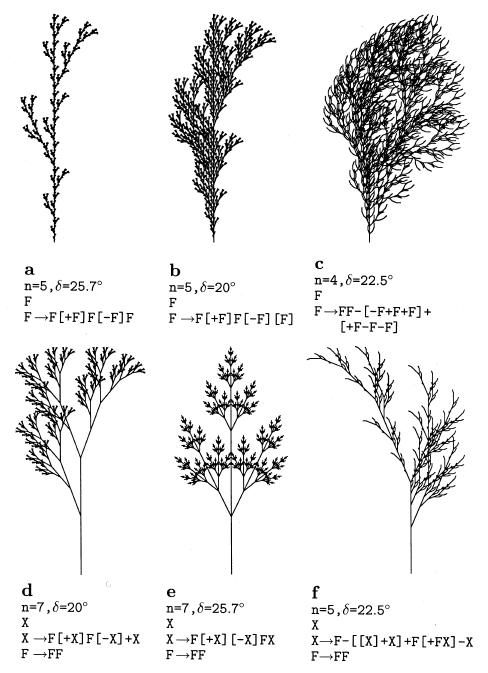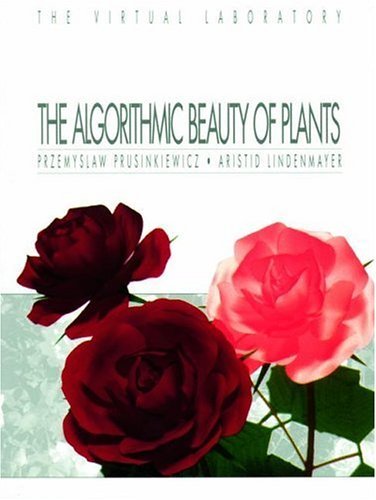| Objective: |
In this assignment, you will learn how to generate a forest of trees using
an iterated function system (IFS) called Lindenmayer Systems (a.k.a. L-Systems), and place those trees
on a "ground plane." You shall also model a car and place it on the ground plane.
This assignment consists of two parts: a "Preparation" part
and a "New Stuff" part.
NOTE: Please submit ONLY the work described below in the section "new stuff" by the due date (Thur Feb 3, 2011, 11.59PM).
Do NOT submit the work you do in the "prep coding" section
|
|
| Preparation: |
The aim of this preparation part is for you to create the IFS for generating the
strings that will define each tree for the forest. In addition, you will create a
PolyCylinder routine to better understand transformations (e.g., translations, rotations) in OpenGL.
A drawing pattern is defined by a turtle string made up of command characters that
control how the turtle moves, as well as its state. The commands include:
| Character |
Meaning |
| F |
Move forward a step of length len, drawing a line (or cylinder) to the new point. |
| f |
Move forward a step of length len without drawing. |
| + |
Apply a positive rotatation about the X-axis of xrot degrees. |
| - |
Apply a negative rotatation about the X-axis of xrot degrees. |
| & |
Apply a positive rotatation about the Y-axis of yrot degrees. |
| ^ |
Apply a negative rotatation about the Y-axis of yrot degrees. |
| \ |
Apply a positive rotatation about the Z-axis of zrot degrees. |
| / |
Apply a negative rotatation about the Z-axis of zrot degrees. |
| | |
Turn around 180 degrees. |
| [ |
Push the current state of the turtle onto a pushdown stack. |
| ] |
Pop the state from the top of the turtle stack, and make it the current turtle stack. |
L-Systems are used to generate a turtle string by iteratively expanding a start token
by applying production (or re-writing) rules. Each L-System consists of a grammar that
defines re-writing rules. Each rule in the grammar consists of a left-hand side (LHS) and a
right-hand side (RHS), separated by a colon.
A sample grammar looks like this:
start: F-F-F-F
F: F-F+F+FF-F-F+F
In addition to specifying a grammar, we also need to specify the values for
len, xrot, yrot, and zrot, as well as a value denoting
how many times we want to iterate (i.e., apply the production rule(s)).
Similar to the way the Koch curve is created by replacing each segment with a predefined
pattern, the turtle string is rewritten by substituting every instance of a LHS by its
corresponding RHS. For any token in the string for which there is no matching LHS, the token
is simply copied into the new string. For example, given the grammar:
start: F+F
F: F-F+F-F
after one iteration, the resulting turtle string would be:
F-F+F-F+F-F+F-F
and after two iterations, the resulting turtle string would be:
F-F+F-F-F-F+F-F+F-F+F-F-F-F+F-F+F-F+F-F-F-F+F-F+F-F+F-F-F-F+F-F
Your system should be able to handle multiple production rules, each having a unique LHS, for example:
start: X
X: F-[[X]+X]+F[+FX]-X
F: FF
Here is an example (in 2D) of some grammars and their corresponding trees. Can you extend these to 3D for
use in this project? (The value of n is the number of iteration, and the angle specified is the
rotation for the "+" and "-" characters.)

|
|
| Setup: |
Copy the Makefile you used in Homework 1, change the names accordingly for your program, and add in the
other modules you have created (e.g., grammar.h grammar.cpp, etc.).
|
|
| Prep Coding: |
-
L-Systems: Write a program that implements the L-System re-writing scheme described above. Your program should
be able to read several grammars from grammar files, store them in appropriate data structures, and
then generate the correct turtle strings by applying the rewriting rules as specified.
Here is a sample L-System file. A description of the file format is contained
in the file itself, and you may assume that all files have the same format.
Compile and run your program!
-
The PolyCylinder: We define a PolyCylinder as a polyline in three dimensions. Given a sequence of
points in 3-space { (x1, y1, z1), (x2, y2, z2), (x3, y3, z3) }, a polycylinder draws a cylinder from
(x1, y1, z1) to (x2, y2, z2), and another one from (x2, y2, z2) to (x3, y3, z3). To avoid "gaps" in the
joints of the polycylinder, a sphere of the same diameter as the cylinders is drawn at each point.
You need to write some code that:
- Moves (translates) to the first point,
- Draws a sphere,
- Points (rotates) towards the next point,
- Draws a cylinder to the next point,
- Moves (translates) to the next point,
- Draws a sphere,
- Points (rotates) towards the next point,
- Draws a cylinder to the next point,
- Moves (translates) to the next point,
- And so on, for all the points in the list.
HINT 1: This part is an exercise in translating and rotating your coordinate system before drawing
your geometry. After you accomplish this, you will understand how transformations are accumulated in OpenGL.
HINT 2: You can simplify your life by always drawing your cylinder along the Z axis. To do this,
apply your rotations such that you are always "moving" along the Z axis by first rotating yourself to point
the current Z direction towards the next point.
Using the description of setting up a simple scene given in the textbook Hill, Example 5.6.2, set up a view of your scene,
draw a ground plane, and draw some PolyCylinders in the scene. You can just come up with some
(x, y, z) points on your own for this. Be creative! Write your name, or something.
Compile and run your program!
|
|
| New Stuff: |
Now we need to put it all together.
-
Using the code you wrote in the preparation section, your program should read in five L-System files,
"lsys1.txt,"
"lsys2.txt,"
"lsys3.txt,"
"lsys4.txt," and ONE OF YOUR OWN, and store them in instances of your grammar
class. You should then apply the re-writing rules for each grammar according to the values specified for this
in each grammar file. Your five L-System files should be drawn on the (a,b,c,d,e) keystrokes respectively. For
instance, hitting keystroke a draws lsys1.txt, etc.
-
Choose a random location on the ground plane to start drawing one of the randomly selected trees, using a
random color, and draw it.
HINT: You should apply a translation and a rotation to move to the correct start location.
-
Repeat Step 2 (at least) 8 times in order to draw your forest. For inspiration, you can look at the
gallery of forests created by students in a previous CS 4731 class HERE
Some of the students in that class used a checkerboard floor. You can just make a plain floor.
- Draw a solid 3D car using OpenGL and place it in your forest.
An approximation of a car would be fine - I wouldn't
expect you to be able to create a state-of-the-art model - but it should be recognizable.
Your car must have at least 25 components. e.g. each sphere, cone, cube, etc counts
as one component.
You should keep the level of detail and complexity in your object low until you get the
basic functionality down, and then use your imagination to make it as interesting as you
wish. For example, a basic car could be approximated with a number of cylinders, spheres
and boxes, and later enhanced by varying sizes, shapes, and detail.
You don't have to add 3D effects like texturing yet since we
haven't covered them in class, although people who decide to add any effects won't have points
taken off.
- Keystroke f draws your forest, ground plane and car.
(If you REALLY want to test your program, try this input file. This is
from p. 20 of the reference book listed at the bottom of this page and is PURELY OPTIONAL!)
|
|
| Attacking the Problem: |
For the L-System part, start out by creating several classes that will help you manage the different things
you will need to keep straight. For example, you might want to have a turtle class consisting of a
position, orientation, length when drawing, and a string representing the turtle
string.
You might want to have a rule class that has strings for the lhs and rhs.
A grammar class would consist of a list of rules, along with a method (addRule) to add
a new rule to the grammar. The main method for the grammar class might be something like a rewrite method
that takes in a turtle and a number of iterations, and returns a new string after applying the
rules to the turtle string for the desired number of iterations.
The functionality for implementing '[' and ']' can be greatly simplified by using the
built-in OpenGL functions glPushMatrix and glPopMatrix. This will save and return you to the proper
state.
Another thing that will help you greatly is to use the Standard Template Library (STL) that is available
with C++. There are a number of classes that you will find very useful, such as "string," "hash_map,"
"multimap," and/or "list." If you have never used these before, this is a good opportunity for you to
"get out of your comfort zone," as these tools will serve you well in most future endeavors, both in this
class and well beyond.
Some good links to C++ help include the SGI site
and also CPP Reference.
|
|
| Documentation: |
You must create adequate documentation for your project in pure ASCII text, and submit it
along with the project. The documentation
does not have to be unnecessarily long, but should explain briefly what each part of your program does, and
how your filenames tie in. Most importantly, tell the TA how to compile and run your program.
|
|
What to
Turn in: |
Submit everything you need to compile and run your program (source files, data files, etc.)
BEFORE YOU SUBMIT YOUR ASSIGNMENT, put everything in one directory on ccc.wpi.edu, compile it,
and make sure it runs. Then tar everything up into a single archive file.
The command to tar everything, assuming your code is in a directory "hw2", is:
tar cvf FirstName_LastName_hw2.tar hw2
To submit your work, you will use the turnin utility on CCC. Here is a link
to instructions about how to do this. The turnin ID for the project is "proj2", so
to submit your new stuff, you would type something like this when logged in to the CCC machine:
/cs/bin/turnin submit cs4731 proj2 FirstName_LastName_hw2.tar
|
|
Academic
Honesty: |
Remember the policy on Academic Honesty: You may discuss the
assignment with others, but you are to do your own work. The official WPI statement
for Academic Honesty can be accessed
HERE.
|
|
| References: |
 |
Most of the motivation for my interest in this work comes from the book
"The Algorithmic Beauty of Plants," by Prezmyslaw Prusinkiewicz and Arstid Lindenmayer,
Springer Verlag, New York, 1990, ISBN 0-387-97297-8, ISBN 3-540-97297-8.
The whole book has been put online by
the author. In addition, there are links to other interesting works on this page.
You can also find it on Amazon.
|
![[Feedback]](../../../../../Emmanuel_files/feedback.gif) ![[Search Our Web]](../../../../../Emmanuel_files/search.gif) ![[Help & Index]](../../../../../Emmanuel_files/help.gif)
![[Return to the WPI Homepage]](../../../../../Emmanuel_files/seal.gif) ![[Return to CS Homepage]](../../../../../Emmanuel_files/new_cs.gif)
mailto:emmanuel@cs.wpi.edu |
![]()

